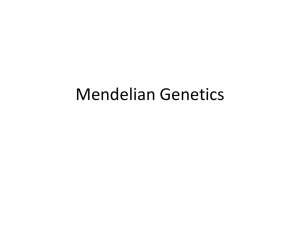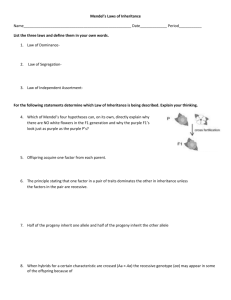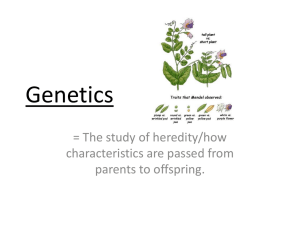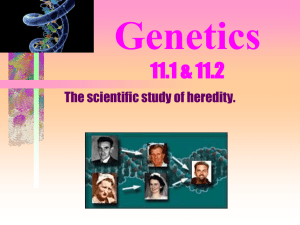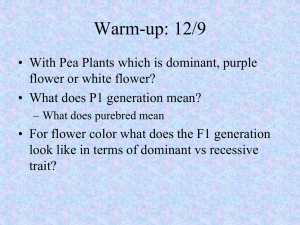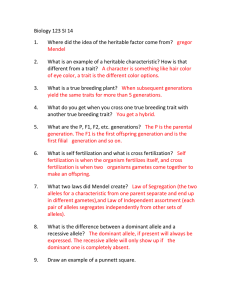Mendel & Monohybrids - Fulton County Schools
advertisement
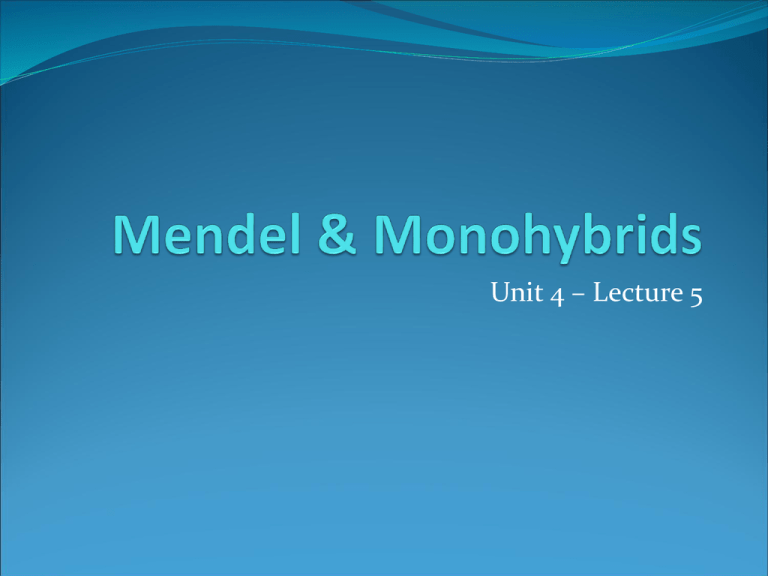
Unit 4 – Lecture 5 Mendel Gregor Mendel – father of genetics / hereditary sci genetics – branch of biology which studies heredity heredity – passing on of traits from parent to offspring monk; mid-1800s Before Mendel… blending hypothesis – idea that all offspring traits are a blend of the parent traits ex: tall + short = medium rejected by Mendel’s work Mendel’s Crosses to “cross” organisms means to breed them together “test-cross” = graphic representation of offspring probabilities Mendel carried out his experiments on pea plants. Mendel’s Crosses Steps to Cross Pea Plants remove stamen [male parts] w/ pollen from one plant use paintbrush to transfer pollen to pistil [female parts] of a plant with a different version of that trait [ex: flower color – white/purple] fertilization = fusion of two gametes [1n +1n = 2n] Mendel’s Crosses Steps to Cross Pea Plants wait for results… then repeat…many times. Mendel’s Crosses – cont’d Example: Purple Flower1+ White Flower 1 Purple Flowers2 …mix two of those purple 2nd generation flowers… Purple2 + Purple2 Purple and White!! So….what happened? First, we have to get some vocabulary… Discuss What is a test cross? Before Mendel’s work, what was the name of idea that most people believed regarding offspring inheriting traits equally from their parents? Helpful Vocabulary Allele – a version of a gene / trait ex: trait = eye color; alleles = brown, blue, etc. Traits are represented by two alleles one from each parent alleles are shown by combinations of letters; each trait you work with will have a different letter. Helpful Vocabulary – cont’d Dominant Allele – is expressed when combined with another allele represented by a capital letter [A, B, C, D, etc] ex: purple flowers, yellow seeds, round seeds Recessive Allele – can be repressed/hidden when combined with another allele represented by a lower-case letter [a, b, c, d, etc] ex: white flowers, green seeds, wrinkled seeds Discuss In Mendel’s work with the pea plants, which was the dominant flower allele? the recessive? In review… what does “homo” mean? “hetero”? Helpful Vocabulary – cont’d GENotype – set of alleles that an organism has for a trait. [it’s genetic combination] homozygous = having two of the same alleles for a trait ex: AA or aa heterozygous = having two different alleles for a trait ex: Aa Helpful Vocabulary – cont’d PHenotype – physical traits an organism has. ex: brown hair, blue eyes, etc. if genotype is homozygous, you will see phenotype of that gene if genes A = purple & a = white AA = purple phenotype / aa = white phenotype if genotype is heterozygous, you will see the phenotype of the dominant gene Aa = purple [recessive is hidden/repressed] Helpful Vocabulary – cont’d Law of Segregation of alleles– you have two alleles per trait each of those alleles will separate so each gamete gets one copy [This is similar to the Law of Independent Assortment – which is basically the same thing, but talking about chromosomes instead of the trait alleles] Mendel’s Crosses Mendel controlled his experiments by: studying ONE trait at a time. choosing plants which showed the same trait through several generations true breeder = plant, when self-fertilized, only produces offspring with the same traits aka homozygous [ex: AA or aa] Discuss What is the difference between a genotype and a phenotype? Give an example of both. What is the difference between Mendel’s Law of Segregation and the Law of Independent Assortment? What is the difference between homozygous and heterozygous? Give an example of each. More Vocabulary P [Parent] Generation – original, typically true-breeding organisms producing offspring F1 [first filial/offspring] Generation – offspring of P generation F2 [second filial/offspring] Generation – offspring of F1 generation Discuss If you are the F2 generation, who in your family would be: the original P generation? the F1 generation? Mendel’s Crosses – cont’d Going back to our original plants: Parent 1 = Purple Flower [true breeder] x Parent 2 = White Flower [true breeder] Which trait was hidden? Which was expressed? aa [white flower] AA [purple flower] Mendel’s Crosses – cont’d Recall – each parent donates a single allele for each trait to their offspring. Parent 1 = AA can only donate ‘A’ alleles Parent 2 = aa can only donate ‘a’ alleles Discuss If you were to cross the parents AA and aa, all offspring have… what genotype [allele combination]? what phenotype [physical appearance]? All F1 offspring are Aa genotype All F1 offspring are purple phenotype Mendel’s Crosses – cont’d Aa = hybrid hybrid = heterozygous offspring of two true- breeding parents What happens if we cross the F1 generation? monohybrid cross = test cross involving one trait ex: eye color OR hair color aka: Punnett Square dihybrid cross = test cross involving two traits ex: eye color AND hair color [at the same time] Creating a Test-cross First, let’s go back and model the Parent to F1 generation Test-Cross draw the test-cross boxes Creating a Test-cross First, let’s go back and model the Parent to F1 generation Test-Cross determine the alleles of each parent, then place each allele next to or above the boxes: a a A A Creating a Test-cross First, let’s go back and model the Parent to F1 generation Test-Cross copy alleles above each column into the boxes of that column A A a A A a A A Creating a Test-cross First, let’s go back and model the Parent to F1 generation Test-Cross copy alleles next to each row into the boxes of that row A A a Aa Aa a Aa Aa Creating a Test-cross First, let’s go back and model the Parent to F1 generation Test-Cross interpret results: [genotypes & phenotypes] genotype ratios: 4/4 or 100% = Aa phenotype ratios: 4/4 or 100% = purple flowers A A a Aa Aa a Aa Aa Creating a Test-cross – cont’d Now, let’s model the F1 generation test-cross. draw the test-cross boxes determine the alleles of each parent, then place each allele next to or above the boxes A a A a Creating a Test-cross – cont’d Now, let’s model the F1 generation test-cross. copy alleles above each column into the boxes of that column copy alleles next to each row into the boxes of that row A a A A A Aa a Aa aa Creating a Test-cross – cont’d Now, let’s model the F1 generation test-cross. interpret results [genotypes and phenotypes]: genotype ratios: 1/4 or 25% = AA [homozygous dominant] ¼ or 25% = aa [homozygous recessive] ½ or 50% = Aa [heterozygous] A a A A A Aa a Aa aa Creating a Test-cross – cont’d Now, let’s model the F1 generation test-cross. interpret results [genotypes and phenotypes]: phenotype ratios: 3/4 or 75% = purple flowers ¼ or 25% = white flowers A a A A A Aa a Aa aa Homework Complete the Super Peas Worksheet title on worksheet: Genetics Practice Problems – Simpl(er) Worksheet
